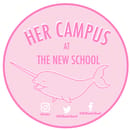In April, it was announced that Parsons School of Design at The New School was selected as one of four colleges and universities that would participate in Beyoncé’s Formation Scholars program, which was newly established to celebrate the one-year anniversary of Lemonade‘s release. The schools included alongside Parsons were Berklee College of Music, Spelman College, and Howard University, each of which selected one woman studying creative arts, music, literature, or African-American studies to be their scholarship recipients.
A few weeks ago, Parsons announced that Avery Youngblood had been selected as the Formation Scholar representing the college. We are humbled to have been able to speak with Avery and hear her open up about what it means to be a Formation Scholar, and how her unique academic background contributes to her work in Graphic Design. Having received her undergraduate degree in Comparative Studies in Race and Ethnicity and Linguistics from Stanford University, Avery Youngblood is now pursuing her AAS degree in Graphic Design, and brings a multifaceted approach to artmaking in our newly charged aged of sociopolitical design.
HC: Tell us what it means to you to be a Formation Scholar:
Avery Youngblood: “I guess I feel responsibility for upholding the characteristics that they looked for. What spoke to me about applying to the scholarship were the characteristics they describe. Someone being bold, outside-the-box, and creative, and willing to go outside the lines of what’s considered normal. That’s the kind of person I want to be, or at least that I want my designs to speak to.”
“And of course, Beyoncé being one of those people that tries to uphold those qualities in herself as someone to look up. She continues to push herself to look from different perspectives, push the boundaries, and always question the direction of where her creative work is going.”
HC: As an artist, in what ways are you inspired by Lemonade and Beyoncé?
AY: “When Lemonade came out, we held a viewing party in my dorm at Stanford, and it was so much fun. It was absolutely breathtaking, and there was a lot to take in and digest. But later I noticed its influence in my work, and when going to apply for the scholarship I found those similarities that I had started to take from this visual album. Her realization of time in the video, how time creates itself as this non-linear concept, is one I noticed, and I built these ideas about how one sees time in accordance to those memories or really distinct points in their lives. They usually revolve around those parts of your identity that really stand out, like your gender, or race, or sexuality. I saw all of this in Beyoncé’s work, and I then noticed it in my own as things that I’m also passionate about.”
HC: How did you react/how did you find out that you were selected as the Parsons Formation Scholar?
AY: “I was at work, and it was a pretty slow day so I was checking my email a lot. But when I got the email I basically started crying at my desk, although the people around me definitely didn’t know what was going on! I couldn’t believe it. I must have checked that email at least 500 times; I was, and am, so thankful, grateful, and humbled by this opportunity.”
HC: You have a unique background in Comparative Studies in Race and Ethnicity and Linguistics, which you studied at Stanford. You’re now pursuing your AAS Degree in Graphic Design, and having seen your work it’s clear that those subjects intersect for you. What do you think are the challenges for artists who make work that exists in the sociopolitical sphere?
AY: “It’s hard to be honest, with your audience, yourself, and what you want. The history that you have and the experiences that lead you to any conclusion is going to be different for everyone, so don’t be afraid to say something truthful in your own language and in your own way of saying it. Know where you’re coming from, but you have to understand all the different perspectives and know that everyone is going to interpret what you’re saying differently.”
HC: How do you feel graphic design is able to channel ideals of race and ethnicity differently than other mediums?
AY: “That’s what I love about Parsons; I came into the program thinking of Graphic Design as one thing and now I see it as so much more. That’s what I’m starting to love, realizing that it’s not just the computer, it’s just so freeing. There’s so many different meanings and ways of translating whatever you’re trying to get across. I don’t necessarily know if there’s a certain way in which you have to showcase your work anymore as a graphic designer, so that’s become the most appealing thing about it. It’s just become a platform in which I can make some sort of design or work of art and not necessarily be boxed in.”
HC: You told PBS, “As you become older, you become more conscious of what’s around you: how everything is geared towards a certain audience or geared towards a certain demographic and you realize you’re not that demographic. I hope to achieve designs that speak to all different types of bodies.” How do you think design plays a role in liberating individuals from the misconceptions of their identities that often hold them back?
AY: “Design can allow people to think. In this visual age, we question what is fact and what is not, we often see everything around us as some form of subliminal messaging. Design has the ability to do just that, but also the exact opposite. It’s like going to a museum and looking at a piece of art and allowing yourself to just ponder about it, instead of blindly absorbing it. Systems of all types, from physical ones like packaging design, or academic, governmental, and federal ones, are all things made by people with probably themselves in mind. That’s what got me thinking that design gives me the ability to actually express my perspective, and not even to appropriate other perspectives, but to learn about them and hopefully cross those boundaries. I hope to either create a physical manifestation of different perspectives or question the systems that we have.”
HC: The group of Formation Scholars is so diverse in their artistic and academic accomplishments; how do you feel you contribute to the group as an individual and an artist?
AY: “I’ve been wondering that too! That’s a good question. I do feel different in terms of my studies, simply because my background has been different. As far as I can see, we’re all strong black women, and that alone gives you a perspective of the world, and some unsaid similarities between yourself and others. These are really expressive, intelligent women, and I guess what’s different in me is that I’m now in the process of translating what I learned in my Bachelor’s studies and applying it to an artistic lens.”
HC: Since you’re in this newfound stage of exploring artistic studies, what do you think the future holds for you?
AY: “I don’t really know! My parents suggested that I study abroad, because I never got the chance and I now have the scholarship funds to support that. I’ve also considered graduating early since more of my credits transferred over from Stanford than I expected, so I figured that gives me the time to go out and research the manifestation of designs in other environments and cultures. It would be nice to have a more global understanding of the stuff I’ve been talking about. I don’t know how that’ll actualize itself, but maybe that’s the next step.”
[Feature image by Avery Youngblood]


